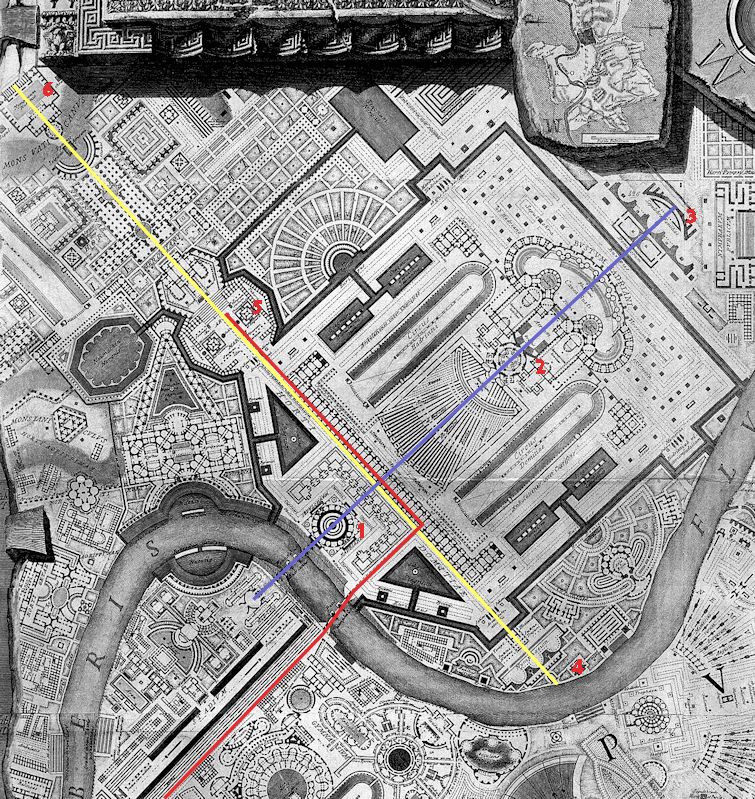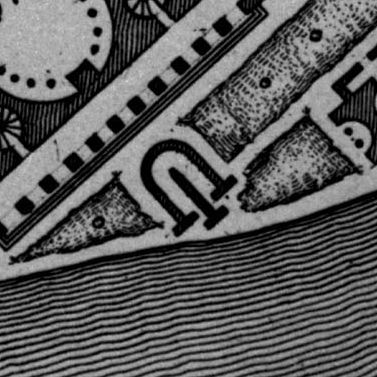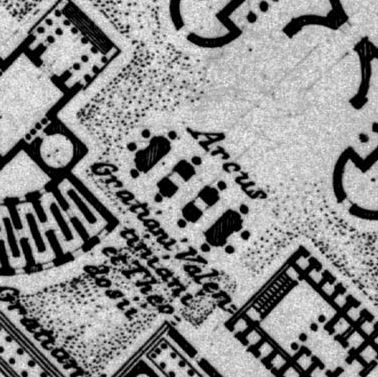Inside the Density of G. B. Piranesi's Ichnographia Campus Martius
life 1 c (1) : the state of a material complex or individual characterized by the capacity to perform certain functional activities including metabolism, growth, repreduction, and some form of responsiveness and adaptability
death 1 : the ending of all vital functions without possibility of recovery either in animals or plants or any parts of them : the end of life : the act , process, or fact of dying 5 : the passing or destruction of something inanimate
Within the Horti Neroniani and the Horti Domitiani, the Gardens of Nero and Domitia respectively, Piranesi establishes two axes that cross perpendicular to each other. One axis is immediately obvious within the large plan in that it coincides with the bilateral symmetry of the Bustum Hadriani, the gigantic crematorium and burial place adjacent to Hadrian's own enormous tomb. It then quickly becomes also obvious that this axis literally delineates death -- at one end there is Hadrian's tomb, and at the other end there is the Sepulchra Familiae Domitiorum, the Sepulchers of the Domitian family, while the middle of the axis contains a mammoth funerary machine.
The opposing axis, on the other hand, is rather obscure in that it only partially aligns with a bilateral symmetry, and, indeed, a large segment of this axis acquiesces to the opposing symmetry of the Hadrianic bustum. Nonetheless, this axis takes precedence both symbolically and in meaning. Near the center and perfectly aligned with this axis sits the Templum Martis and the Area Martis, thus the initial route of the Triumphal Way. This nucleus of beginnings and victory then counters the Bustum Hadriani's central position along the axis of death. Furthermore, two nympheum anchor each end of this axis, hence also countering the two giant sepulchers of the axis of death. Piranesi's design of this axis then is in every way opposite the axis of death, thus delineating an axis of life.
| |

The yellow line indicates the axis of life. The purple line indicates the axis of death. The red line indicates the Triumphal Way.
1. Sepulchrum Hadriani 2. Bustum Hadriani
3. Sepulchra Familiea Domitiorum
4. Nymphaeum
5. Templum & Area Martis
6. Nympheum Neronis
|
In a most subtle way, Piranesi further underscores the opposition of the life and death axes with two relatively tiny buildings. There is, at the beginning of the axis of life, an unnamed and unspecified building along the bank of the Tiber. It is clear by plan alone, however, that this building animates sexual intercourse, more specifically the Martian rape of Rhea Silvia and the very beginnings of Rome itself. On the other hand, the building at the very end of the axis of death is the Arcus Gratiani, Valentiniani et Theodusii, the Arch of Gratian, Valentinian and Theodosius. It was the Emperor Theodosius who, in 385 AD, essentially "killed" paganism when he decreed Christianity the Roman Empire's official and only religion.
| |

the tiny unmarked "intercourse" building at the beginning of the axis of life
|

the Arcus Gratiani, Valentiniani et Theodusii at the end of the axis of death
|
| |
1999.12.08 12:37
hello, thanks, reading your book
hello Hilde,
Among other things, this is an 'unofficial' thank you to NeTHCA for inviting me to speak at Inside Density. It was indeed an honour and a pleasure to participate, especially since my relative isolation from 'real' architectural dialogues is now pretty much a constant of my day to day life. Inside Density provided a significant dose of 'reality' into my otherwise 'virtual' architectural existence.
I also want to thank you for driving me back to my hotel after Elia's and Eleni's Thanksgiving dinner (which, by the way, is the USA's biggest reenactment feast). Since returning home to Philadelphia, I've actually been quite ill--a severe head cold mixed with sporadic asthma--and the best I could do was read in bed. Fortunately, I was able to borrow Architecture and Modernity from Temple University's architecture library before my cold set in, hence, I've been reading your book (kind of backwards, actually). I first had to read you views regarding mimesis, particularly to see how they might relate to the notion of (architectural) reenactment. There certainly is a relationship between the two concepts, and I now seriously wonder if a comparison/contrast of the two would in fact further develop their respective 'meanings'. I repeatedly recall your question to me at Inside Density regarding the relation of reenactment and theater, and perhaps you and I could continue to address this subject via an email dialogue. (I actually like having theoretical dialogues via email because the method requires the writing down of ideas, and, if the dialogue continues for a sustained length of time, it is always somewhat remarkable in that a significant and valuable document subsequently comes into being.) One of the nicest occurrences for me last week (while sick in bed) was reading your writing relative to some things Mark Wigley wrote (A+M, pp. 195-6), and then realizing that I was in a car with both of you just a few days prior--an unexpected pleasure all around.
Last night, I read the end of A+M's chapter three, the School of Venice. I have never completely (and actually barely partially) read Tafuri's History and Theories of Architecture, and I am now grateful for your concise synopsis of 'operative criticism' and/or versus 'historical criticism'. The whole notion of 'operative criticism' fits precisely within my own feelings relative to how the notions of 'virtual' and 'computer aided design' are treated within the current architectural lexicons, debates, etc., specifically, with regard to my activities at Quondam in that my quest as an architect attempting to forthrightly create a 'virtual' building within the Internet/world wide web is still largely being ignored by the architectural field at large. Can you name another architect besides myself that is specifically trying to (and indeed succeeding at) creating a 'virtual' building that goes all over the world rather than requiring people coming to it? Is the lack of 'official' recognition for Quondam just another example of 'operative criticism' still very much at work? (I'm sorry for sounding a bit too self absorbed, but I sincerely believe I do have a clear and distinct point.) In any case, since I am now very much interested in 'operative criticism' and 'historical criticism', could you recommend any further reading that I might do on these subjects?
I hope to finish reading A+M within the next two weeks. So far, however, I can already say you did an excellent job. Hopefully your text will become required reading for many architects today and in the future.
Steve Lauf
|


